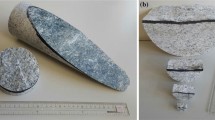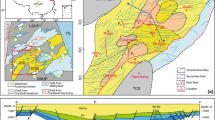Abstract.
A set of 3873 cracks on exposed granite rock surfaces are analyzed in order to investigate possible fracture mechanisms. The fracture patterns are compared with the Mohr-Coulomb and the Roscoe fracture models, which can be combined into a single fracture scheme. A third model for comparison is based on interacting `penny-shaped' micro cracks introduced by Healy et al. [Nature 439, 64 (2006)]. The former models predict a bimodal fracture angle distribution, with two narrow peaks separated by 60○-90○ symmetrically on both sides of the direction of the largest principal stress, while the latter predicts a single broader peak in the same direction with standard deviation in the range 15○-20○. The crack length distributions seem consistent with numerical simulation, whereas the fracture patterns are Euclidean rather than fractal. The statistical analyses indicate that none of the models fully describe the fracture patterns. It seems that natural shear fractures easily become a complex combination of different fracture mechanisms.
Similar content being viewed by others
References
A.A. Griffith, Phil. Trans. R. Soc. A 221, 163 (1921)
Statistical models for the fracture of disordered media, edited by H. Herrmann, S. Roux (North-Holland, Amsterdam, 1990)
J. Fineberg, M. Marder, Phys. Rep., 313 (1999)
J.A. Åström, Advances in Physics 55, 247 (2006)
J.M. Ramsey, F.M. Chester, Nature 428, 63 (2004)
K. Roscoe, Geotechnique 20, 170 (1970)
G. Kirsch, Zeitschrift der Vereines Deutscher Ingenieure 42, 797 (1898)
J. Arthur, T. Dunstan, Q. Al-Ani, A. Assadi, Geotechnique 27, 53 (1977)
D. Healy, R.R. Jones, R.E. Holdsworth, Nature 439, 64 (2006)
J.D. Eshelby, Proc. R. Soc. Lond. A 241, 376 (1957); J.D. Eshelby, Proc. R. Soc. Lond. A 252, 561 (1959)
A.N.B. Poliakov, H.J. Herrmann, Geophys. Res. Lett. 21, 2143 (1994)
D.L. Turcotte, Fractals and chaos in geology and geophysics (Cambridge Univ. Press, 1997)
The fracture patterns have been extracted by SKB ltd. which is the Swedish company responsible for nuclear waste management. Information on SKB and the Äspö Hard Rock Laboratory can be found under http://www.skb.se
J. Hermanson, O. Forssberg, A. Fox, P. La Pointe, SKB-report: SKB R-05-45 (available at http://www.skb.se) Statistical model of fractures and deformation zones. Preliminary site description, Laxemar subarea, version 1.2 (2005)
C. Darcel, P. Davy, O. Bour, J.-R. De Dreuzy, SKB-report: SKB R-04-76 (available at http://www.skb.se) Alternative DFN model based on initial site investigations at Simpevarp (2004)
M.J. Zoback, V. Zoback, J. Mount, J. Eaton, J. Healy, Science 238, 1105 (1987)
J.A. Åström, H.J. Herrmann, J. Timonen, Eur. Phys. J. E 4, 273 (2001)
Author information
Authors and Affiliations
Corresponding author
Rights and permissions
About this article
Cite this article
Åström, J. Statistical analysis of shear cracks on rock surfaces. Eur. Phys. J. B 56, 291–295 (2007). https://doi.org/10.1140/epjb/e2007-00138-y
Received:
Published:
Issue Date:
DOI: https://doi.org/10.1140/epjb/e2007-00138-y




